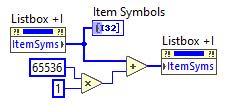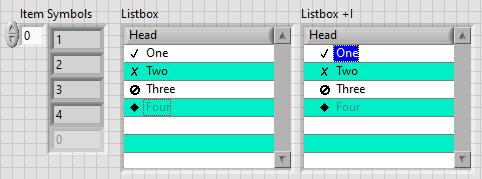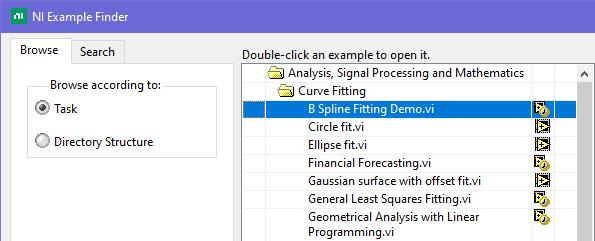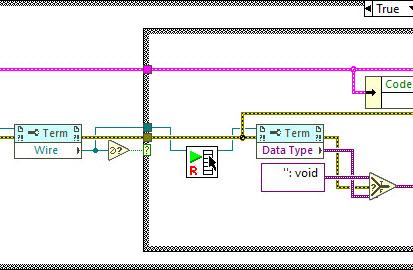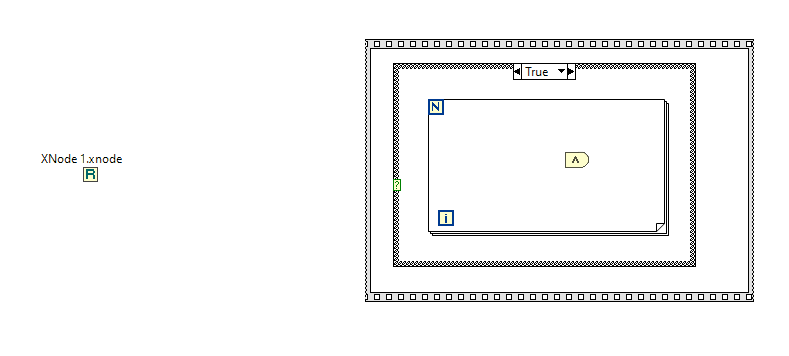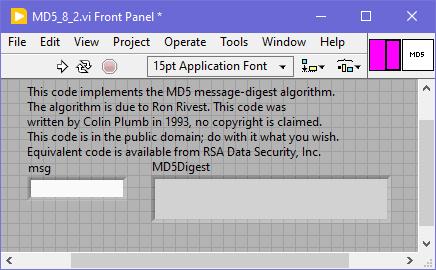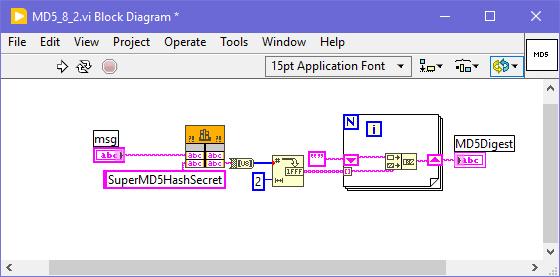-
Posts
365 -
Joined
-
Last visited
-
Days Won
39
dadreamer last won the day on November 11
dadreamer had the most liked content!
Profile Information
-
Gender
Male
LabVIEW Information
-
Version
LabVIEW 2025
-
Since
2010
Recent Profile Visitors
8,117 profile views
dadreamer's Achievements
-
I haven't had much time to investigate this until this month, but I think I've found the cause. XNodes on the production computer were not designed optimally. In the AdaptToInputs ability I was unconditionally passing a GenerateCode reply, thinking that the AdaptToInputs is only called when interacting with the XNode (connecting/disconnecting wires). It turned out that LabVIEW also calls the AdaptToInputs ability once, when the VIs are loaded and any single change is made, no matter if it touches the XNode or not. As I had many such non-optimal XNodes in many places, it was causing code regeneration in all of them. Besides of that some of my VIs had very high code complexity (11 to 13), because of a bunch of nested structures. When the XNodes regeneration was occurring simultaneously with the VIs recompilation, it was taking that a minute or so. After I added extra conditions into my AdaptToInputs ability (issue a GenerateCode reply only, when the Term Types are changed), the edits in my VIs started to take 1.5 seconds. Still the hierarchy saves can be slow, when some 'heavy' VIs are changed, but it's a task for me to refactor those VIs, so their complexity could decrease to 10 or less. By the way, my example from the previous page was not suitable for demonstrating the situation, as its code complexity is low and the Match Regular Expression XNode does not issue a GenerateCode reply in the AdaptToInputs.
-

Sort (search) Array of cluster by one cluster element
dadreamer replied to Bobillier's topic in LabVIEW General
You want an ability to override the Equality or Comparison operators? I'm unsure, whether it really existed in OpenG packages, but now you have those neat malleable VIs, that let you do that: Search Unsorted 1D Array , Sort 1D Array , Search Sorted 1D Array. They have an additional input to specify your own equals or less function in a form of a custom comparison class or a VI refnum. There's an article to help: Creating a Custom Sorting Function in LabVIEW -
This is exactly what was said in that ancient thread: Tree control in labview. So if you add 65536*N to the Item Symbols property of the Listbox and have the "Enable Indentation" option activated, you shift the symbol/glyph and the text N levels to the right. Could be useful for simple 'parent-child' relationships, if you don't want to use a Tree. And still it's used in Find Examples / NI Example Finder window:
-

How to extract a circular ring from a Image?
dadreamer replied to Wang xiang yang002's topic in LabVIEW Community Edition
IMAQ Unwrap VI Example is at \LabVIEW 20xx\examples\Vision\Image Management\Unwrap Barcode.vi. For U16 images also see this: IMAQ Unwrap Example - not working properly with U16 image type? -
About a minute for a change, that's what I've seen on a production machine. On my home computer it's as on yours though: a single edit takes 1-2 seconds. I'm still investigating it. I will try different options such as enabling those ini keys or disabling the auto-save feature. To me it looks like the whole recompilation is triggered sometimes. By the way, there are more keys to fine-tune XNodes: I haven't yet figured out the details.
-
Looks like Block Diagram Binary Heap (BDHb) resource took 1.21 MB and the rest is for the others. There are 120 Match Regular Expression XNodes on the diagram. If each XNode instance is 10 KB approximately, and they all are get embedded into the VI, we get 10 * 120 = 1200 KB. The XNode's icon is copied many times as well (DSIM fork). So, the conclusion is that we shouldn't use XNodes for multiple parallel calls. The less, the better, right? Ok. The load time seems to reduce with these tokens: Still the editing is sluggish tho.
-
4. WinAPI version using ChooseColor function. NativeColors.rar Far from ideal, don't kick too hard. 🙂 Determine Clicked Array Element Index is from here.
-
Well, I see no issues when running XNodes at the run-time, when everything is generated and compiled. What I see is some noticeable lags at the edit time. Say, I have 50 or even 100 instances of one or two XNodes in one VI, set to their own parameters each. When compiled, all is fine. But when I make some minor change (create a constant, for example), LabVIEW starts to regenerate code for all the XNodes in that VI. And it can take a minute or so! Even on a top-notch computer with NVMe SSD and loads of RAM. Anyone experienced this? I've never seen such a behaviour, when dealing with VIM's. Tried to reproduce this with a bunch of Match Regular Expression XNodes in a single VI. Not on such a large scale, but the issue remains. Moreover the whole VI hierarchy opens super slowly, but this I've already noticed before, when dealt with third party XNodes. xn.vi
-
I kind of liked this idea and wished VIM's could allow for such a backpropagation. Even had a thought of making an idea on the dark forums. But then I played a while with the Variant To Data node. It doesn't play well. It can't determine a sink, if a polymorphic VI is connected or even when a LV native (yellow) node is connected. Borders of structures are another issue, obviously. So, it'd require making two ideas at least: to implement VIM backpropagation and to enhance the Variant To Data node. (As a hack one could eliminate the Variant to Data in their code with coerceFromVariant=TRUE token, but then the diagram starts to look odd and no error handling is performed). If someone still wants the code, shown in the very first post, it's here: https://code.google.com/archive/p/party-licht-steuerung/source/default/source?page=3 (\trunk\PLS-Code\PLS Main.vi). And these are the papers to progress through the lessons: LabVIEW Intermediate I Successful Development Practices Course Manual. Nothing interesting there for an experienced LV'er though. XNodes demonstrated here work a way better, and could be a good alternative (if you're OK with unsupported features, of course). As I tried to adapt them for my own purposes, I decided to improve the sink search technique. It surprised me a bit, that there's still no complete code to walk through all the nested structures to determine a source/sink by its wire. Maybe I didn't search well but all I found was this popup plugin: Find Wire Source.llb. It stops on Case structures though. I have reversed its logic to search for a sink instead of a source and tried to apply recursion, when it encounters a Case structure. Well, it's still not ideal, but now it works in most my cases. There are some cases, when it cannot find a sink, e.g. wire branches with void terms: Too many scenarios to process them all. Nevertheless, this little VI might be useful for someone. You may use it as a popup plugin, of course, or may pull out that Execute Find Wire Destination (R).vi and use it in your XNodes. As an example: Find Wire Destination.llb Already tried such nodes in a work project. I must admit that not all the time back-propagation is suitable, so about 50/50. But when it's used, it works.
-

Find most recently created or modified image(file)
dadreamer replied to mooner's topic in LabVIEW General
In addition to the LV native method, there are options with .NET and command prompt: Get Recently Modified Files. -

LabVIEW Build Array Bug #1: Unexpected Array Growth
dadreamer replied to Joel Foster's topic in LabVIEW Bugs
I remember I even had an idea, that would make it easier to track such situations: Add Array Size(s) Indicator. In design time it would cost almost nothing. Although I admit, its use cases are quite rare. -
Started playing with XNodes a bit and noticed the same behaviour as well. Really upsetting. But there is the solution. Just send FailTransaction reply in a Cancel case in the OnDoubleClick ability of your XNode and that 'dirty dot' never appears! That's exactly what the Timed Loop XNode does internally. Looking at this description I get the impression that this reply was invented precisely to overcome that bug (was even given its own CAR #571353). Similar thread for cross-reference: LabVIEW Bug Report: Error Ring Edit + Cancel modifies the owning VI
-
For an odd reason I don't see such a function in LabVIEW 5.x, 6.x and 7.x. It appears only in 8.2, maybe it's available since 8.0 too, can't check right now. Well, I ran a quick binary search for "GetMD5Digest" word and found, that such a function was being used in ...\LabVIEW 8.2\vi.lib\imath\engines\lvmath\Utility\MD5.vi. That VI was password-protected, the password was calvinthegorilla (😁) and, of course, was removed like 1-2-3. Here's the VI to play: MD5_8_2.vi As shown, the prototype is still correct, just some extra "secret" / key was applied. Works well in LV 2023 Q3 64-bit.
-
The Create NI GUID.vi is using App.CreateGUID. On Windows App.CreateGUID private method calls CoCreateGuid function, which could be easily called directly from BD, as shown in that cross-posted link.
-
The task of intercepting WM_DDE_EXECUTE message has been around for a while here and there. Except that private OS Open Document event there are two more ways to get this done. 1. Using Windows Message Queue Library 2. Using DDEML of WinAPI and self-written callback library More details can be found in this thread. I now think that it could even be simplified a bit, if one could try to hack that internal LinkDdeCallback function and reuse it like LabVIEW does. But I feel too lazy to check it now.





